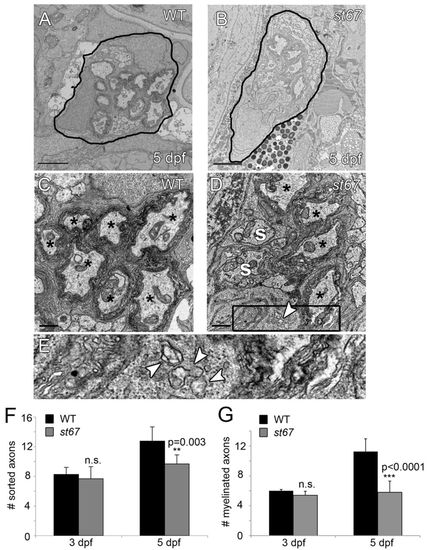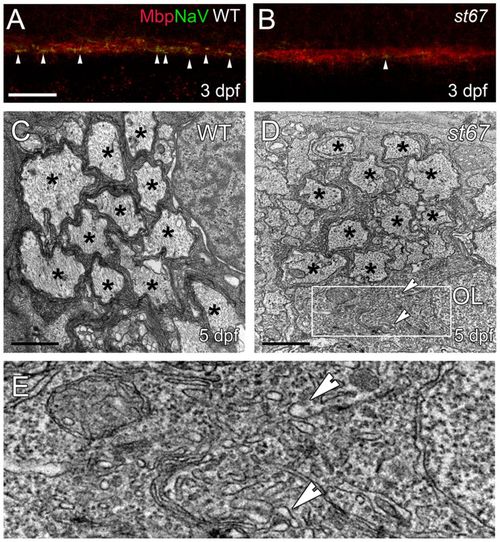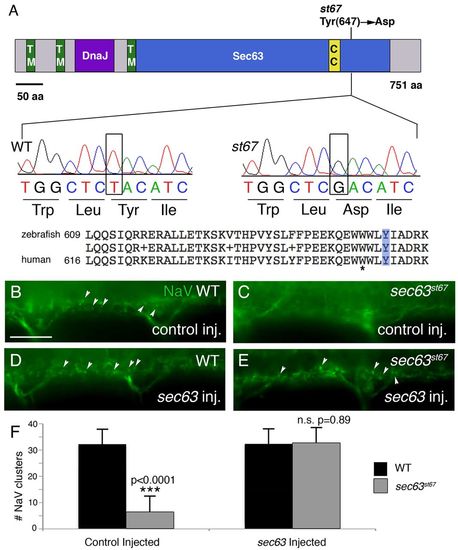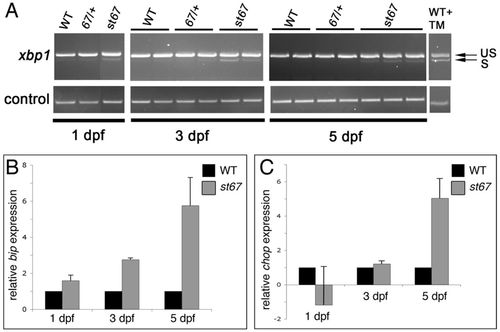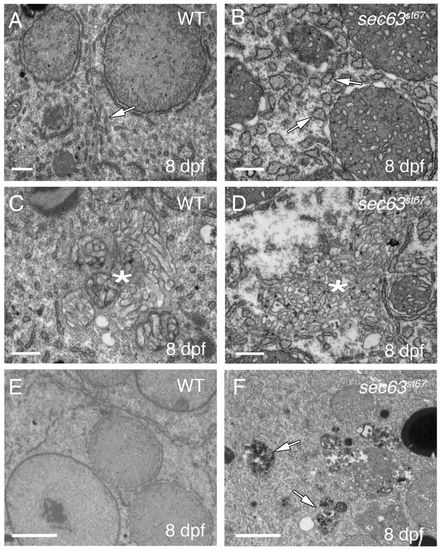- Title
-
Mutation of sec63 in zebrafish causes defects in myelinated axons and liver pathology
- Authors
- Monk, K.R., Voas, M.G., Franzini-Armstrong, C., Hakkinen, I.S., and Talbot, W.S.
- Source
- Full text @ Dis. Model. Mech.
|
Nodes of Ranvier are abnormal in st67 mutant zebrafish at 5 dpf. (A?D) Images of axons from the posterior lateral line nerve (PLLn) in larvae of the indicated genotypes at 3 (A,B) and 5 dpf (C,D). Axons were double-labeled with antibodies against acetylated tubulin (AcTub, red) and NaV (green). NaV labeling is shown alone in A′?D′. In wild-type and st67 mutant larvae, NaV clusters (arrowheads) appear as discrete labeled puncta. At 3 dpf, no differences are observed in either frequency or morphology of NaV clusters in st67 mutants compared with wild type (A,B). At 5 dpf, st67 mutants have fewer NaV clusters and many NaV clusters are more diffuse than in wild-type PLLn (C,D). (E) Quantification of the total number of NaV clusters along the entire length of the PLLn in wild-type and st67/+ larvae (WT, black bars) compared with homozygous st67 mutants (st67, gray bars) at the indicated developmental stages. P values for unpaired t-test comparisons (two-tailed) are shown; error bars indicate s.d. Sample sizes: at 3 dpf, 23 siblings (WT and st67/+) and 9 mutants; at 4 dpf, 18 siblings and 8 mutants; at 5 dpf, 7 siblings and 9 mutants. Genotypes were assessed by PCR after photography. Scale bars: 10 μm (A?D). PHENOTYPE:
|
|
PLLn axons are hypomyelinated in st67 mutants. (A?E) TEM images showing cross-section through the PLLn at 5 dpf. Sorted axons(s) are completely surrounded by Schwann cells and some sorted axons are myelinated (*). In the wild type (A,C), many axons are surrounded by several wraps of myelin at 5 dpf. In st67 mutants (B,D), fewer axons are myelinated at 5 dpf, and irregular Schwann cell cytoplasm is observed with visibly swollen endoplasmic reticulum (D). (E) Blow-up of boxed region in D showing swollen ER (arrows). (F,G) A significant decrease in both sorted (F) and myelinated (G) axons was detected in st67 mutant larvae at 5 dpf, but not at 3 dpf. The P values for unpaired t-test comparisons (two-tailed) are shown; error bars indicate s.d. Sample sizes: at 3 dpf, 4 nerves from 4 siblings and 6 nerves from 5 mutants; at 5 dpf, 8 nerves from 5 siblings and 6 nerves from 3 mutants. All larvae were imaged at and quantifications made from approximately the same location along the anterioposterior axis, at the level of the 7th hemisegment. Scale bars: 2 μm (A,B); 0.5 μm (C,D). |
|
Nodes of Ranvier are disrupted in the spinal cord of st67 mutants and the spinal cord axons are hypomyelinated. (A,B) Myelin basic protein (Mbp, red) and NaV (green) antibody staining in the ventral spinal cord at 3 dpf. No differences can be seen in the intensity of Mbp stain in st67 mutants (B) compared with siblings (A), but NaV puncta (arrowheads) are greatly reduced in st67 mutants (see also Fig. 4). (C?E), TEM images showing cross-sections through the ventral spinal cord at 5 dpf. (C) At 5 dpf, many axons in sibling spinal cord are surrounded by several wraps of myelin (*). (D) Fewer axons are myelinated (*) in st67 mutant spinal cord, and irregular oligodendrocyte cytoplasm was observed with visibly swollen ER (arrowheads) in all mutants examined. (E) Enlarged view of the boxed region in D. In D and E, arrowheads denote swollen ER. Sample sizes: 8 wild-type and heterozygous larvae and 3 mutant larvae. Scale bars: 20 μm (A,B); 1 μm (C,D). PHENOTYPE:
|
|
st67 disrupts zebrafish sec63. (A) Representation of Sec63 showing functional domains and the location of the lesion in the st67 mutation. TM, transmembrane domain; DnaJ, DnaJ domain; Sec63, Sec63 domain; CC, coiled-coil region. Also shown are sequence traces from homozygous wild-type and st67 mutant larvae. The st67 mutation changes a conserved tyrosine to an aspartic acid in the Sec63 domain. A comparison of zebrafish and human Sec63 amino acid sequence in the vicinity of the st67 mutation is also shown. The light blue box indicates the location of the lesion in st67 zebrafish mutants. The asterisk marks the position of a SEC63 mutation identified in human patients with PCLD (W651G) (Waanders et al., 2010). (B?E) Representative images of antibody-stained preparations of the spinal cord of larvae of the indicated genotypes and injection treatments at 72 hpf. (B) Siblings injected with control solution show normal NaV clustering (arrowheads). (C) st67 mutants injected with control solution show aberrant NaV clustering. (D,E) Siblings and st67 mutants injected with 150 pg of synthetic sec63 mRNA show normal NaV clustering. (F) Quantification of the total number of NaV puncta in two hemisegments (<200 μm) of ventral spinal cord of sibling (black bars) and st67 mutant larvae (gray bars) at 72 hpf following the indicated injection regimes. The P values for unpaired t-test comparisons (two-tailed) are shown; error bars indicate s.d. Sample sizes: 9 control-injected siblings. 6 control-injected mutants, 12 sec63-injected siblings and 11 sec63-injected mutants. Scale bar: 20 μm (B?E). PHENOTYPE:
|
|
Markers of ER stress are elevated in sec63st67 mutants. (A) RT-PCR showing expression of spliced and unspliced xbp-1 in individual larvae of the indicated genotypes and developmental stages. During the UPR, a 26-nucleotide fragment of xbp-1 mRNA is spliced. RT-PCR shows that the spliced form of xbp-1 (S) is enriched in sec63st67 mutants compared with wild-type (WT) and st67/+ larvae. Unspliced xbp-1 (US) is present in all samples. As a positive control for the assay, wild-type larvae treated with the ER stressor tunicamycin show upregulation of the spliced form of xbp-1. (B,C) qRT-PCR showing relative expression of UPR markers bip (B) and chop (C) in wild-type and heterozygous siblings (WT) vs sec63st67 mutant larvae (st67) at the indicated stages. Error bars indicate s.d. PHENOTYPE:
|
|
sec63st67 mutants develop numerous liver pathologies. (A?F) TEM images showing liver ultrastructure at 8 dpf in wild-type and sec63st67 mutant zebrafish. (A) Wild-type liver; arrow points to ER with normal morphology. (B) sec63st67 mutant liver; ER is swollen (arrows) and cytoplasm is disrupted. (C,D) Ultrastructure of bile canaliculi (*) in wild-type (C) and sec63st67 mutant (D) livers. sec63st67 bile canaliculi appear disorganized compared with the wild type. Lysosomes are filled with debris in sec63st67 mutants (F; arrows) but not in the wild type (E). Scale bars: 500 nm (A?D); 2 μm (E,F). PHENOTYPE:
|
|
sec63st67 mutants develop liver steatosis. (A?F2) Lateral views of larvae stained with Oil Red O of the indicated genotypes and at the indicated developmental stages. (A?C) Arrows indicate the location of the liver in 5 dpf larvae. sec63st67 mutant livers (C, n=7) are indistinguishable from wild-type (A, n=6) or heterozygous (B, n=12) livers. (D?F) Boxed regions denote the areas enlarged in D′?F′. (D′?F′) Outlines denote the liver in 8 dpf larvae. sec63st67 mutant livers (F,F′, n=8) show stronger Oil Red O stain than wild-type (D,D′, n=14) or heterozygous (E,E′, n=34) livers. Scale bars: 200 μm. PHENOTYPE:
|

Unillustrated author statements PHENOTYPE:
|


